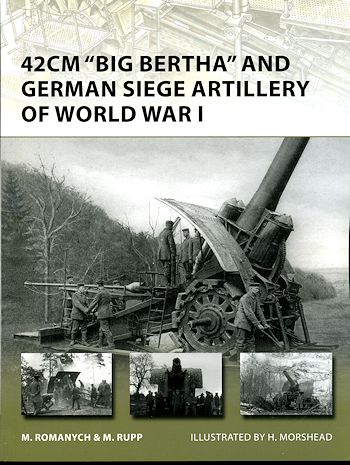 Osprey's New Vanguard series is
probably my favorite of all the different lines of books that Osprey produces. I
am just a fan of equipment and that is the major concentration of this series.
This latest one is on something of which most of us have heard, but little more;
siege artillery. Specifically, the 42cm siege guns called 'Big Bertha' and her
sisters.
Osprey's New Vanguard series is
probably my favorite of all the different lines of books that Osprey produces. I
am just a fan of equipment and that is the major concentration of this series.
This latest one is on something of which most of us have heard, but little more;
siege artillery. Specifically, the 42cm siege guns called 'Big Bertha' and her
sisters.
Siege artillery is something that the Entente nations did not have and
their use of these guns came as a real shock to the French, Belgians and British
when the Germans put them to use. Their major function was to destroy fortified
positions and they were quite successful in that regard. Of course, due to the
size of the guns, they were not easy to get into position and they had to be
well hidden so as not to be able to be destroyed by anti-artillery return fire.
The first guns developed in this line were the 30.5 cm Beta-Gerät. A
total of nine of these 30 ton guns were built. These were based on an 1893
design and when built a few years later, were sufficient to punch through any
fortifications then in existence. However, the gun had some drawbacks. One was
its weight, a situation that required it to be moved in pieces and then
reassembled. The other was its range. While it was pretty good at nearly 8,200
meters, it was not outside the range of the guns of French forts. After these
guns were built, interest waned.
It was not until the successes of the Japanese against the Russians at
Port Arthur in 1905 that interest was rekindled and it was decided to build even
larger guns. This increase in size was also due to the improvements in fort
design and materials with reinforced concrete and improvements in plate steel
being able to withstand a lot more punishment. This brought about the 42 cm
Beta-Gerät.
By the time the war started in 1914, Germany had two of these big
howitzers built, but they were not put into action right away as it was hoped
that the speed of the German army would bring about a quick end to hostilities.
This did not happen and so the first use of these guns was against Belgian
forts.
The
42 cm Beta-Gerät was not a small gun and required extensive time to set
up. It required seven rail cars just for the gun and the crane used to
reconstruct it. Rail tracks had to be built to where the gun was to be sited and
then the area had to be prepared. Even the crane required dual tracks to the
site and tracks that ran on either side of the gun. Then there was the large
crew and the equally large ammunition, which had to be loaded in sections.
However, the gun was extremely successful and came as quite a surprise
to the Entente as they not only had nothing like it, but were quite unaware of
its existence. Nothing could withstand the pounding provided by these guns and
while things were not perfect (several guns exploding during use during the
war), no fortification could stand in their wary. Eventually several more were
built.
As successful as the 42.cm guns were, it was decided that something a
bit more mobile was needed so the 42.cm
M-Gerät was developed. This gun was on great wheels and featured a
longer barrel. However, it was not as successful as its predecessor. It was
found that large charges would burst the barrel and so its range was less than
the fixed gun. This meant more danger from return fire as the gun had to be
closer. There was also a distinct lack of fortified positions against which to
use the gun by the time it entered service so it, along with its bigger and
smaller siblings were used as standard artillery through the rest of the war.
In all, this is turned out to be a fascinating book on a subject few
have written. It is quite well done and I'd have to add this to the growing list
of books that any enthusiast needs to have on their shelves.
Highly recommended reading.
February 2014
For more on the complete line of Osprey books,
visit www.ospreypublishing.com. In the US, it is
Osprey Direct at 44-02 23rd St, Suite 219, Long Island City, NY 11101., where you can
get a catalogue of available books.
If you would like your product reviewed fairly and
fairly quickly, please
contact
the editor or see other details in the
Note to
Contributors.
 Osprey's New Vanguard series is
probably my favorite of all the different lines of books that Osprey produces. I
am just a fan of equipment and that is the major concentration of this series.
This latest one is on something of which most of us have heard, but little more;
siege artillery. Specifically, the 42cm siege guns called 'Big Bertha' and her
sisters.
Osprey's New Vanguard series is
probably my favorite of all the different lines of books that Osprey produces. I
am just a fan of equipment and that is the major concentration of this series.
This latest one is on something of which most of us have heard, but little more;
siege artillery. Specifically, the 42cm siege guns called 'Big Bertha' and her
sisters.